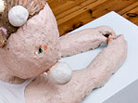Polska — Niemcy 4:6 — wystawa zbiorowa polskich i niemieckich artystów

Artyści biorący udział w wystawie:
Marcin Berdyszak
Jacek Jagielski
Kamil Kuskowski
Leszek Lewandowski
Wiebke Bartsch
Jupp Ernst
Carsten Gliese
Anja Jensen
Dietmar Schmale
Sabine Swoboda
Pomysłodawcy wystawy: Leszek Lewandowski i prof. Marcin Berdyszak
Kurator: Marta Raczek
Koordynator (Niemcy): Martin Rehkopp

„Polska — Niemcy 4:6” — działania polskich i niemieckich artystów biorących udział w wystawie Publikacja przedstawia działania polskich i niemieckich artystów biorących udział w wystawie „Polska — Niemcy 4:6”....

Wystawa „Polska — Niemcy 4:6” została pomyślana jako artystyczny dialog, za pośrednictwem którego opowiedziana zostanie historia i teraźniejszość stosunków polsko-niemieckich. Celem prezentacji jest zwrócenie uwagi na wielowymiarowość sąsiedzkiej koegzystencji obu narodów, których dzieje znaczone były zarówno sojuszami — epoka Ottona III i Bolesława Chrobrego — jak i tragicznymi momentami, wśród których na szczególną uwagę zasługuje okres II wojny światowej, zwłaszcza że wystawa odbywa się w roku siedemdziesiątej rocznicy jej wybuchu. Sam tytuł wystawy, nawiązujący do faktu, że polska reprezentacja w piłce nożnej nigdy nie zdołała pokonać reprezentacji Niemiec, sugeruje, że jej przedmiotem nie jest jedynie wielka historia, lecz także zjawiska z zakresu kultury popularnej i codziennych relacji. Punktów wyjścia może być bardzo wiele: historia polityczna, stereptypy we wzajemnym postrzeganiu obu narodów, problem fali masowych emigracji z Polski do Niemiec w latach osiemdziesiątych, poprzez czasowe lecz bardzo lukratywne wyjazdy na „zaksy” (sachsy), a także kwitnący swego czasu przemyt utrwalony m.in. w kabaretowej piosence Janusza Rewińskiego: „Zigaretten nach Berlin, zblatowany celnik śpi — to nie wróci już — Kryśka swym maluchem mknie, szmuglujemy jak we śnie – to nie wróci już…”, aż po dzisiejszą sytuację w przygranicznych miastach, do których Niemcy przyjeżdżają na wizyty dentystyczne i do fryzjerów, a ostatnio w weekendy, żeby zapalić papierosa przy piwie w barze, odkąd w Niemczech wprowadzono zakaz palenia w lokalach. Celem wystawy jest także dekonstrukcja wizerunku Niemca i Polaka utrwalona wzajemnie przez obie kultury, zwłaszcza w popularnym kinie, serialach, piosenkach czy powieściach.
Ważnym kontekstem dla wystawy jest również miejsce jej prezentacji — Śląsk. W gwarze śląskiej przetrwało wiele germanizmów, śląskie przyśpiewki przypominają nieco niemieckie piosenki biesiadne, a idea festynów nieobca jest zarówno Ślązakom, jak i Niemcom. Pomimo tych zbieżności, obie kultury przynależą do odmiennych porządków, przechowując jednocześnie w sobie to, co można odczytać, jako swoistą wartość wspólną.
Ostatnim tropem, na który warto zwrócić uwagę, jest dialog artystyczny, w który wejść mogą ze sobą poszczególni artyści, po raz kolejny potwierdzając, że sztuka nie zna granic, ani paszportów, a podobne problemy, czy rozwiązania formalne są obecne po obu stronach granicy.
Ideą wystawy nie jest rywalizacja — jak mógłby sugerować zaczerpnięty z piłkarskiej frazeologii tytuł – lecz gra pomiędzy znaczeniami, zderzenie ze sobą różnorodnych poglądów, a także ukazanie odmiennych postaw wobec sztuki wyrastającej z odrębnych tradycji, zarówno społecznych, jak i artystycznych. Tytuł „Polska — Niemcy 4:6” stanowi dobrą metaforę, która odnosi się zarówno do oficjalnej historii stosunków polsko-niemieckich, jak i do kontaktów z sąsiadami na najbardziej podstawowym — codziennym — poziomie. Jednocześnie odwołanie do piłki nożnej zwraca uwagę, że gra ta nie jest tylko rywalizacją, lecz również pracą zespołową, w ramach której jedynie skłonna do współpracy drużyna jest w stanie wygrać. Artyści biorący udział w wystawie odwołują się do stosunków polsko-niemieckich na wielu różnych poziomach, ukazując je zarówno w optyce uniwersalnej, jak i w kontekście komunikatów przekazywanych w ramach popkultury. W roku obchodów siedemdziesiątej rocznicy wybuchu II wojny światowej wystawa staje się potrzebnym i ważnym głosem podsumowującym okres ostatnich pięćdziesięciu lat stosunków Polski z zachodnim sąsiadem, unikając jednocześnie kategorycznych sądów i wymykając się stereotypowym ujęciom. Sztuka od wieków pełniła funkcję soczewki skupiającej najważniejsze przemiany społeczno-kulturowo-obyczajowe, wystawa może stać się zwierciadłem dla obu narodów zachęcającym zarówno do wnikliwego przyjrzenia się przeszłości, jak i odważnego spojrzenia w przyszłość wzajemnych stosunków i wypracowania dla nich nowej formuły.
Kuratorka: Marta Raczek








